Effective Strategies for Removing Chocolate Stains
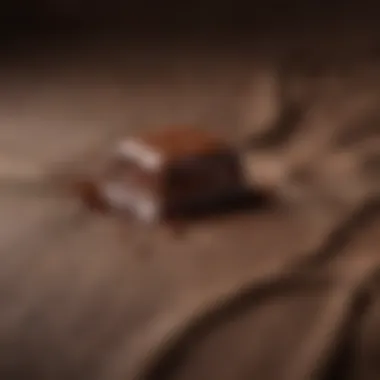
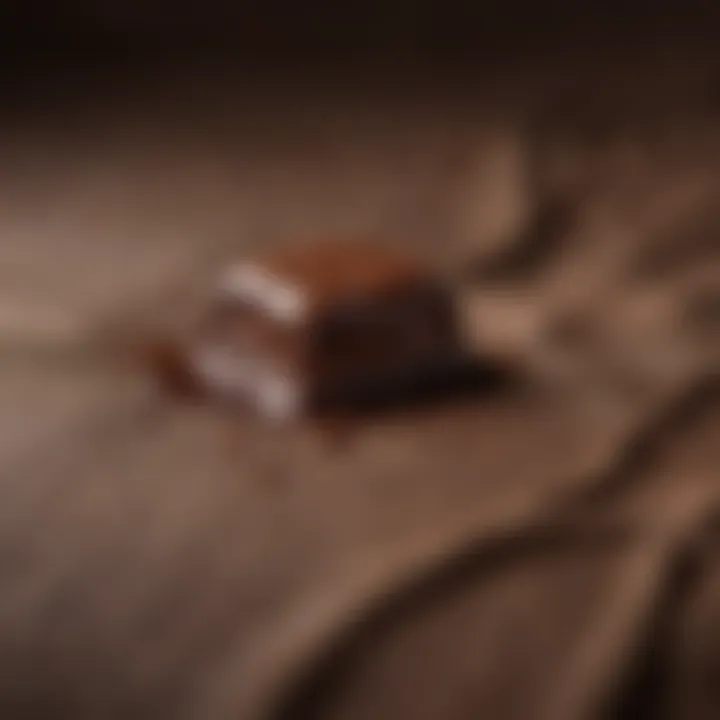
Intro
Chocolate stains can create distress for anyone. A simple slip can turn into quite a mess. When the decadent treat meets fabric, retaining that garment's integrity becomes a challenge. It is essential to address these stains promptly to prevent them from setting. Each method used has its own importance. Various household items and cleaning products play a key role in this process. Understanding these strategies can aid in both preserving clothing quality and effectively tackling stubborn chocolate marks.
This article will explore effective combinations of treatments. By breaking down procedures into manageable steps, readers can feel empowered. Pre-treatment options will be examined first, followed by laundry solutions and post-treatment inspections. A thorough understanding of these methods will create confidence in reducing future staining incidents.
Understanding Chocolate Stains
Chocolate stains are more than just a simple mishap in the culinary or social event space; they represent a common concern for many individuals. Recognizing how chocolate interacts with fabric is crucial for effectively removing these stains. Understanding chocolate stains not only helps in the immediate response to an accident but also contributes to long-term garment care strategies.
Composition of Chocolate
Chocolate is made up of several components that can lead to staining. Primarily, it consists of cocoa solids, cocoa butter, sugar, and sometimes dairy products. The oils in cocoa butter are particularly troublesome; they can seep into the fabric fibers and become stubborn if not treated promptly. Dark chocolate, for example, has a higher concentration of cocoa solids, which can intensify the staining. Knowing this composition allows individuals to choose the appropriate cleaning methods and products.
"Understanding the makeup of chocolate aids in developing effective stain removal strategies."
How Chocolate Stains Clothing
The process of chocolate staining occurs almost instantly once it comes into contact with fabric. The oily nature of chocolate means it can penetrate deep into fibers, making it difficult to remove if left untreated. When the chocolate melts from body heat or warm environments, it can spread even further, exacerbating the situation. Different fabrics react differently to stains; for instance, cotton may absorb chocolate more quickly than polyester. This variability underscores the necessity for tailored treatment methods based on the material type. Addressing chocolate stains effectively depends on understanding not just the stain itself but the fabric that it affects.
Immediate Actions After a Spill
Addressing a chocolate stain requires immediate attention to effectively mitigate the damage. Delay in action can lead to a deeper penetration of the chocolate, making it more challenging to remove. Taking prompt actions not only enhances the chances of successful stain removal but also alleviates the stress of damage to your clothing.
Act Fast: The Importance of Prompt Action
When faced with a chocolate spill, acting quickly is crucial. As chocolate consists of cocoa, fat, and sometimes milk, these components can seep into the fabric fibers over time. By taking immediate action, you minimize the likelihood of the stain setting in. Research indicates that the first few moments after a spill are critical for successful stain removal. For additional information, consider visiting Britannica for further reading on stain removal techniques.
Align your actions with the following steps:
- Assess the Stain: Determine the extent of the spill to shape your response.
- Gather Supplies: Collect cold water, a cloth, and potentially a stain remover.
Acting fast shows your clothing the care it deserves and prevents further issues down the line.
Carefully Removing Excess Chocolate
After you have acted promptly, the next step involves careful removal of excess chocolate. Use a dull knife or a spoon to gently scrape away any excess from the fabric. Begin from the outer edge of the stain and work towards the center to prevent the stain from spreading. Do this with caution, as excessive force might damage the fabric.
After scraping, use a cloth or paper towel. Dab the area gently to lift any remaining chocolate residue. Avoid rubbing, as this may drive the stain deeper into the fibers. By employing precise techniques, you not only remove the stain but also treat your garment with the care it needs.
"The key to effective stain removal is always to treat it as quickly as possible. Prompt actions can prevent a minor issue from becoming a major one."
Pre-Treatment Techniques
Pre-treatment techniques are a crucial step in the process of removing chocolate stains from clothing. By addressing a stain promptly and effectively, a greater chance for complete removal is achieved. These techniques can prevent the stain from setting, making washing easier and more effective. Understanding the right methods can save time and effort and prolong the life of garments.
Using Cold Water
Using cold water is one of the first recommendations for handling chocolate stains. Cold water helps prevent the stain from adhering more firmly to the fabric fibers. Hot water can cook the proteins in chocolate, making the stain harder to remove. When rinsing the stained area with cold water, one should do so from the back of the fabric. This helps push the chocolate out rather than forcing it in deeper. It’s effective and simple, making it a standard first step in treatment.
Applying Stain Removers
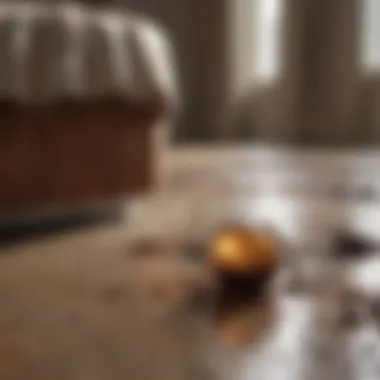
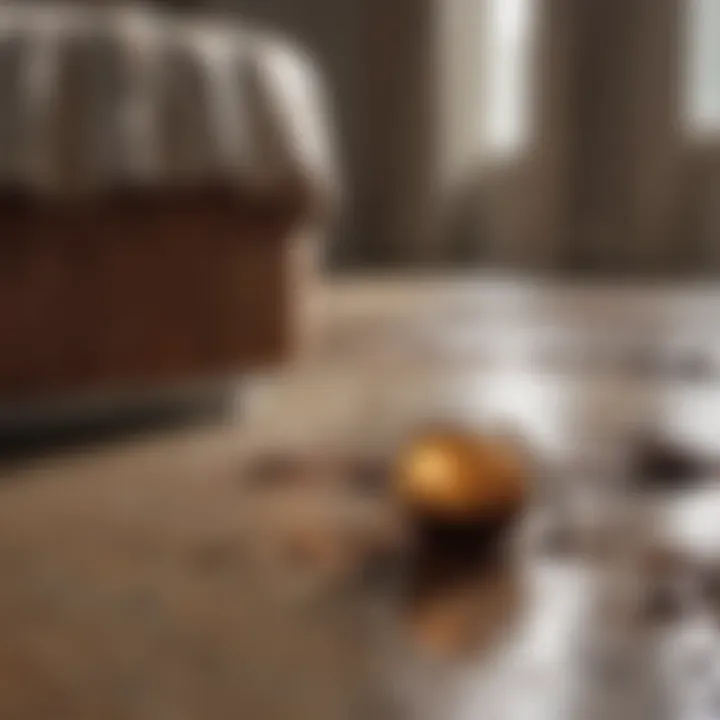
Commercial Stain Removers
Commercial stain removers are formulated specifically to target and lift tough stains, including chocolate. The primary characteristic of these products is their combination of potent cleaning agents that can break down the components in chocolate, such as fats and sugars. Many users prefer commercial solutions for their convenience and efficacy. These products often come with specific instructions that guide users on the correct usage, temperature, and timing for optimal results.
However, it is essential to note that some commercial stain removers might contain harsh chemicals. This could potentially harm delicate fabrics or affect colors. Testing on an inconspicuous area before applying is wise.
DIY Solutions
DIY solutions are an increasingly popular choice for many homeowners. These methods capitalize on easily available household items like vinegar, baking soda, or dish soap. A primary benefit of DIY solutions is their safety. Most ingredients are non-toxic and gentle enough for all fabric types.
For example, a paste made from baking soda and water can be applied to the stain and left to sit before rinsing. Another effective method involves a mixture of vinegar and dish soap. This approach showcases versatility and allows homeowners to tackle stains without needing to purchase specialized products.
Still, DIY methods may require more time and effort. Results can vary based on the severity of the stain and the fabric type. Users should be prepared for some trial and error along the way.
Testing for Colorfastness
Before applying any treatment to a stained item, testing for colorfastness is essential. This process involves testing a hidden area of the fabric with the cleaning solution. If there is no discoloration or fading, the solution is suitable for use on visible areas. Ignoring this step can lead to unwanted damage or fading of colors. It is an important step to ensure that treatment will not further ruin the garment.
"Testing before treatment is not just a precaution; it is crucial for maintaining the integrity of your garment."
Washing and Rinsing Strategies
Washing and rinsing techniques are crucial components in the effective removal of chocolate stains from clothing. Once the pre-treatment processes have been completed, the right washing and rinsing strategies can significantly enhance stain removal efficiency. This section highlights the importance of considering both water temperature and detergent choice, which play vital roles in achieving optimal results.
Selecting the Right Temperature
When removing chocolate stains, temperature selection is a key factor. Cold or lukewarm water is generally preferred initially, as hot water can set the stain into the fabric. Chocolate contains both fats and sugars, which can bond more firmly when subjected to heat. Therefore, washing with cold water helps in loosening the stain without making it worse.
Consider the following:
- For immediate cleaning, run the stained area under cold water to help rinse out some of the material before anything else.
- After the pre-treatment, again use cold or lukewarm water for the washing cycle.
- Always check the care label of the clothing as some materials may require specific temperature settings.
Choosing Appropriate Detergents
Selecting the right detergent is essential for effective chocolate stain removal. The type of detergent can influence the cleaning process, and it is important to consider both commercial and DIY solutions.
- Commercial Detergents: Choose a high-quality liquid laundry detergent. Liquid detergents can penetrate stains better compared to powder. Look for formulations that target grease, as chocolate contains a fair amount of fat. Brands like Tide and Persil are often recommended for their stain-fighting capabilities.
- DIY Solutions: If you prefer to use homemade alternatives, consider mixing dish soap with water. Dish soap is designed to cut through grease, making it an effective option against chocolate stains. Mix one tablespoon of dish soap with two cups of cold water for a simple yet effective solution.
- Enzyme-based Detergents: These can be particularly effective on protein-based stains. For chocolate, enzyme-based options can help in breaking down the proteins, optimizing the cleaning process.
In addition to selecting the right detergent, ensure that the correct amount is used. More detergent does not always equate to better cleaning; follow the packaging instructions and adjust according to the size and soil level of your load.
"Proper washing and rinsing can make the difference between a successful stain removal and a lingering mark on your favorite clothes."
Effective washing and rinsing strategies can significantly impact the outcome of chocolate stain removal. Selecting the right temperature and detergent maximizes the chances of success, leading to cleaner and well-maintained clothing.
Post Treatment Inspection
After you have followed the steps for removing a chocolate stain from clothing, the post treatment inspection becomes essential. This process involves evaluating whether your efforts were successful and determining the next steps, if necessary. It is crucial to ensure that no remnants of the stain linger after washing. If any trace remains, you risk the stain becoming permanent, especially if the garment is dried afterward.
Evaluating the Stain Removal Success
To effectively evaluate the stain removal success, examine the treated area under adequate lighting. Natural light is typically best. Look closely to see if any chocolate color, oily residue, or discoloration persists. If the stain is gone, you can proceed with drying the clothing. However, if you still see the chocolate stain, it’s time to consider further treatment options.


While inspecting, consider these points:
- Stain Visibility: Are there any remaining traces?
- Fabric Damage: Has the treatment caused any fading or wear?
- Water Resistance: Is there any repellent effect from the stain removal agents?
For delicate fabrics, ensure that there has been no change in texture or color after treatment.
Re-Treatment Options if Necessary
If your inspection reveals that the chocolate stain is still present, you should reconsider your treatment approach. Re-treating the stain requires selecting the right solutions again, keeping in mind the material of your garment.
- Cold Water Soaking: Start with a cold water soak before using any chemical agents. This can sometimes loosen the stain further.
- Additional Stain Remover: If the stain remains, apply a more concentrated stain remover. Look for products with enzymes that target protein-based stains. Ensure to follow the manufacturer’s instructions carefully.
- Homemade Options: Consider using vinegar and baking soda as a more gentle re-treatment option. These aforementioned items often work well on most fabrics without damaging them.
- Repeat Laundry: If the stain persists after additional application, wash the garment again following the previous steps. If the stain is stubborn, it may require multiple treatments and a bit of patience.
- Mix one part vinegar with two parts water.
- Apply it directly to the stain and gently scrub with a soft brush.
- Rinse thoroughly after 15 minutes.
In short, post treatment inspection is not merely a completion of the cleaning process, but a pivotal step in ensuring garment longevity and aesthetic integrity.
In summary, a formal post treatment inspection is crucial to ensuring all chocolate stains have been effectively removed. This stage is not only about confirming success but also about identifying if additional intervention is required to address any remaining marks.
Long-Term Stain Management
Long-term stain management is essential for ensuring the durability and appearance of your clothing. Chocolate stains can be particularly stubborn if they are not dealt with promptly and effectively. Understanding how to manage these stains over time can prevent the need for drastic measures such as professionally cleaning or even replacing garments. This section addresses key elements, benefits, and considerations regarding long-term stain management.
Maintaining your clothing involves strategies that encompass both regular care and immediate actions after an incident occurs. By implementing a routine maintenance plan, individuals can greatly reduce the risk of staining becoming permanent. This not only saves time and resources but also prolongs the life of your garments.
Routine Maintenance for Stain Prevention
Regular care of your clothing is crucial in minimizing the risk of chocolate and other stains. Here are some effective strategies:
- Pre-Treating Garments: Apply a fabric spray or a mild detergent to areas that are prone to stains, such as cuffs and collars. This acts as a barrier against potential staining.
- Choosing Stain-Resistant Fabrics: When buying new clothing, consider fabrics that are treated for stain resistance. This can significantly impact how easily stains are removed later.
- Regular Washing: Maintain a consistent washing schedule. Leaving dirt and food particles on fabric can cause them to set into the fibers over time, making stains harder to remove.
- Immediate Spot Cleaning: If a spill does occur, try to address it immediately by blotting the area with a damp cloth. This can help dilute the stain before it has a chance to set.
By adopting these practices, the likelihood of chocolate stains becoming a lingering issue diminishes.
Storage and Care Recommendations
Storing clothing properly is another essential element in long-term stain management. Here are several recommendations:
- Use Breathable Storage Bins: Cotton bags or bins with ventilation can keep fabrics fresh and less susceptible to staining agents while preventing moisture build-up.
- Avoid Direct Sunlight: Store garments in a cool, dark place. Direct sunlight can fade colors and weaken fabric integrity.
- Check Garments Periodically: Inspect clothing every few months. Look out for any signs of stains that may have been overlooked, especially in areas that are not regularly visible.
- Keep Away from Food Areas: Store clothing away from areas where food is often consumed, reducing the risk of spills.
"Preventive maintenance is an investment in your wardrobe's longevity. Always be vigilant about how your clothing is handled and stored."
Special Considerations for Different Fabrics
Understanding how to effectively remove chocolate stains involves more than just knowing the right cleaning techniques. Different fabrics require tailored approaches due to their unique properties. By recognizing these differences, homeowners can apply the most appropriate solutions without damaging their garments. This section identifies the key considerations for handling both delicate and sturdy fabrics.
Handling Delicate Fabrics
Delicate fabrics such as silk, lace, and certain synthetic materials require a gentle approach to stain removal. Due to their fragile nature, the risk of damage increases significantly with harsh treatment. Thus, it is crucial to act thoughtfully.
- Act Swiftly: The sooner the stain is addressed, the better the chances of successful removal. Use a blunt knife or a spoon to gently lift any excess chocolate off the surface of the fabric, being careful not to rub it in.
- Water Temperature: Always use cold water for rinsing delicate fabrics. Hot water can set the stain and also damage the fibers.
- Mild Detergents: Choose a mild detergent made specifically for delicate items. Test it on a hidden part of the fabric to ensure it won’t cause discoloration.
"When dealing with delicate fabrics, less is often more. A gentle touch can preserve the integrity of your garments."
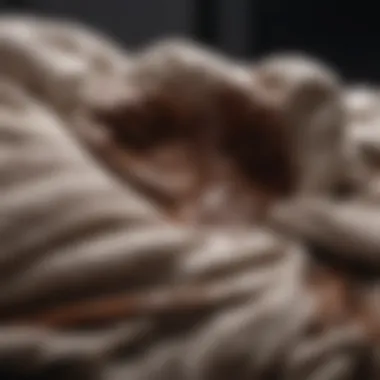

- Spot Treatments: Instead of soaking the entire garment, apply the detergent only on the stained area. Use a soft cloth to dab the stain, avoiding any scrubbing action.
- Air Drying: After cleaning, let the fabric air dry rather than using heat. Heat can shrink or distort delicate fibers.
By following these guidelines, individuals can reduce the risk of fabric damage while effectively dealing with chocolate stains on delicate garments.
Treating Sturdy Fabrics
Sturdy fabrics like cotton, denim, and polyester are generally less sensitive than delicate ones, making chocolate stain removal somewhat easier. However, the cleaning method must still be appropriate to avoid potential wear over time.
- Pre-Treatment: Remove excess chocolate as with delicate fabrics. Use a spoon or blunt edge and work from the edges toward the center to contain the stain.
- Soaking: For stubborn stains, consider soaking the fabric in cold water with a bit of detergent added for about 30 minutes before washing.
- Higher Temperatures: Sturdy fabrics can usually handle warmer water, so refer to the care label when selecting the wash temperature to use.
- Stain Removers: Commercial stain removers can be effective. Ensure it’s suitable for the specific type of fabric being treated. Apply directly onto the stain, allow it to sit for the directed time before washing.
- Rinse Thoroughly: After washing, ensure that all detergent and residue are thoroughly rinsed out to avoid any build-up that could lead to more stains or yellowing.
Sturdy fabrics provide a variety of options for stain removal, allowing more aggressive methods compared to delicate fabrics. It is essential to balance effectiveness with care, ensuring longevity of the garment's quality.
By noting these specific approaches relative to the fabric type, individuals can choose their strategies wisely. This targeted enactment aids in achieving effective stain removal while preserving the integrity of their cherished clothing.
Utilizing Professional Cleaning Services
Engaging professional cleaning services can be a valuable option for those dealing with stubborn chocolate stains on clothing. While many stains can be effectively treated at home, there are instances when professional care is the best course of action. This section addresses important factors concerning professional services, helping readers understand when it is necessary and what results they can expect.
When to Seek Professional Help
Several situations may prompt individuals to contact a professional cleaner. Understanding these scenarios can save time and prevent further damage to clothing. Consider seeking professional assistance if:
- The fabric is delicate: Materials such as silk, cashmere, or fine wool can be easily harmed by improper treatment. A professional has the expertise to handle these fabrics carefully.
- The chocolate stain is old: Over time, stains can set in and become increasingly difficult to remove. Professionals have access to advanced cleaning solutions that might lift old stains more effectively than home remedies.
- Multiple stains are present: If clothing has various stains, tackling them with a professional service can ensure comprehensive treatment rather than piecemeal solutions.
- Time constraints exist: Busy schedules can limit one’s opportunity to manage stains effectively. A professional can save time and provide results without requiring any effort on the part of the homeowner.
What to Expect from Professional Services
Utilizing professional cleaning services typically comes with several benefits that ensure a better outcome than doing it alone. Understanding these can help set realistic expectations:
- Assessment of the fabric: Professionals examine the garment to determine the best cleaning method. They consider fabric type, stain composition, and any previous treatments.
- Specialized equipment and solutions: Unlike household cleaning tools, professional services utilize advanced materials and methods. This includes steam cleaning, dry cleaning, and eco-friendly cleaning agents, customized for specific fabrics and stains.
- Expert stain removal techniques: Trained cleaners have extensive experience and knowledge about stain removal. They can apply tried-and-true techniques to achieve the best results without damaging the garment.
- Post-cleaning follow-up: Some services include a follow-up assessment to ensure customer satisfaction. This might involve discussing results with the client and providing care recommendations for the future.
Using professional services for chocolate stains can offer peace of mind. Knowing your garments are in skilled hands allows you to focus on other important tasks.
Ending
The conclusion serves as a vital component of this article on removing chocolate stains from clothing. It distills the key strategies discussed throughout, emphasizing their effectiveness in addressing one of the most common stain challenges. Understanding these methods can significantly benefit individuals looking to maintain the integrity of their garments while combating stubborn chocolate stains.
In this concluding section, we summarize the important techniques, providing clear recall of the actions one can take to tackle these stains efficiently. The benefits of prompt action, the effectiveness of both commercial and DIY stain removers, and the importance of proper washing and rinsing strategies are highlighted once more. Each step contributes to a comprehensive approach that ensures the chances of successful removal are maximized.
This article also serves as a reminder to consider the fabric type in gauging the appropriate method for stain removal. Delicate fabrics require careful handling, while sturdier fabrics can endure more aggressive cleaning processes. An understanding of these nuances influences the success of the stain treatment.
Adopting these effective strategies can save clothing from irreparable damage and enhance the overall life of garments. With a proactive approach, equipped with the knowledge shared in this article, readers can tackle chocolate stains with confidence and ease.
"Understanding how to manage stains effectively is integral to maintaining a tidy wardrobe."
Recap of Key Techniques
This article presented a step-by-step guide for stain management focusing on chocolate. Here are the primary techniques discussed:
- Immediate Attention: Always act swiftly when dealing with fresh chocolate stains. Prompt action helps prevent deeper penetration of the stain into the fabric.
- Pre-Treatment Choices: Cold water plays a key role in loosening chocolate. Following this, various stain removers—both commercial options and DIY solutions—should be applied.
- Correct Washing Methods: Choosing the right wash temperature and detergent can significantly enhance the cleaning process. For most stains, a gentle cycle with an appropriate detergent works best.
- Post-Treatment Evaluation: Never assume success after a single wash. Inspect the fabric after treatment. If traces of the stain remain, consider re-treatment with special attention to the type of fabric.
Final Thoughts on Stain Management
Effective stain management necessitates a deliberate approach, blending quick action with informed techniques for treatment. Each step from initial response to post-wash inspection is crucial. This article aims to empower homeowners and those who engage in hosting or caring for textiles in recognizing that maintaining clean clothing is achievable.
Long-term stain management involves not only reacting but also developing habits for routine maintenance. Regular inspections and immediate treatment of accidental stains can prevent permanent damage. Proper storage and care recommendations contribute to longevity in garments, thus ultimately influencing the need for less frequent and intensive stain-removal efforts.
Understanding chocolate stains and their removal can transform the way seriousness of stains is regarded. With the right knowledge and techniques, anyone can develop confidence in their ability to manage chocolate stains effectively.















